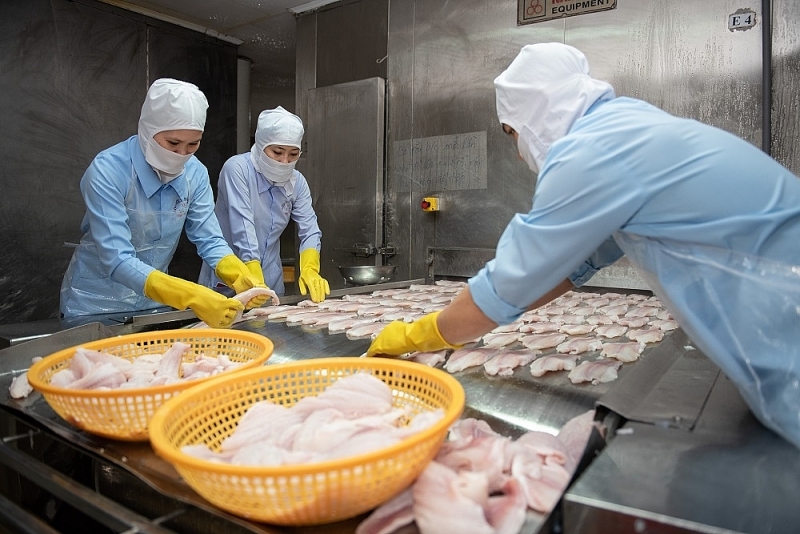 |
| Processing seafood for export at Fimex Vietnam Company. Photo: TL |
The declaration time is not appropriate
At the recent conference, two new Government decrees related to the fisheries sector were introduced, including Decree No. 37/2024/ND-CP (referred to as Decree 37), effective from May 19, 2024, supplementing some articles of Decree 26/2019/ND-CP dated March 8, 2019 of the Government detailing some articles and measures to implement the Law on Fisheries and Decree No. 38/2024 /ND-CP (Decree 38), effective from May 20, 2024, regulates administrative sanctions in the fisheries sector. Businesses believed that the content of the two above-mentioned decrees has many new points, including many regulations directly related to the enforcement of fisheries laws by seafood export enterprises.
However, in the new contents of the two decrees as mention above, seafood businesses especially pay attention to some regulations that make businesses confused and concerned about compliance because there are many inadequacies and unreasonable points.
Specifically, Decree 37 amends and supplements Article 70 related to the control of foreign ships exploiting, transporting, and transshipping aquatic products and aquatic products originating from exploitation and arriving at Vietnamese ports. At the same time, Decree 37 supplements Article 70a on controlling aquatic products and aquatic products originating from exploitation transported by container ships imported into Vietnam.
Accordingly, businesses believe that it is not feasible to comply with the regulations on notification and declaration of documents 72 hours before docking for foreign ships and 48 hours for container ships as prescribed in the above two articles, because both of these timelines are too long and not suitable for short transport routes of ships and containers.
Many businesses import raw materials from Southeast Asian countries, and the time it takes for ships to transport goods to Vietnamese ports is less than 2 days (48 hours). With goods imported by container, when the goods are on board the ship at the port of export, businesses only have information to make documents and documents, so importing businesses have no way to declare 48 hours or 72 hours in advance like regulations. Therefore, businesses believe that it would be more appropriate to require notification before customs clearance instead of notification before arrival at the port.
In addition, businesses ask the authorities to guide which authorities they will have to report and declare to, and request unification of the declaration form. The reason is that, Article 70a, it is prescribed to declare information about the shipment according to form No. 17B.KT Appendix IV issued under the Decree, but this form is not included in the appendix, instead there is Form 25.
Confused about the concept of “mixing ingredients”
Besides the above shortcomings, businesses also reflected that the regulation on the requirement to submit a captain’s certificate is also a complicated procedure for import businesses. The content of the Captain’s Certificate must show information about the vessel exploiting seafood and aquatic products imported into Vietnam, including ship name, ship registration number, flag country, fishing license number, type of fishing gear, exploitation time and exploitation area, date and location of the ship’s first landing, which confirms that the fishery is exploited in full compliance with current laws, management and conservation measures. With so many contents, it is difficult for importers to respond and businesses may lose their source of supply because of this complicated procedure.
Article 70b, Section 6, Point c of Decree 37 stipulates: Do not mix aquatic raw materials originating from imported exploitation with aquatic raw materials originating from domestic exploitation into the same export shipment. Meanwhile, Decree 38/2024/ND-CP only mentions penalties for mixing aquatic materials originating from domestic exploitation but does not mention the phrase “from the same export shipment”.
According to Ms. Le Hang, Communications Director of the Vietnam Association of Seafood Exporters and Producers, the above regulations are confusing for businesses because they do not know how the concept of “mixing materials” in the same shipment is understood. How is that correct? Because the above two decrees and the current Fisheries Law do not have a specific definition of the act of “mixing materials”.
In fact, for seafood businesses, it is completely normal to produce finished products of a shipment with raw materials from many species, many items, from different sources such as exploitation and import, as long as the business can trace the origin of the product and have all the certificates according to regulations.
Typically, many seafood businesses produce mixed goods or typical value-added products such as skewered seafood including raw materials from tuna, filefish… some species originate from domestic exploitation, and some species from imported sources, although each type of raw material can be traced, the regulation “do not mix raw materials” in Decree 37 makes businesses worried.
Some businesses are concerned with the concept of “mixing raw materials”, because most export “finished” seafood, not “raw” seafood.
Furthermore, according to EU recommendations, raw material documents are not allowed to be exchanged, not mixed materials are prohibited. Therefore, businesses suggest that it is necessary to clarify the concept of “mixing materials” in this provision, otherwise, it will be difficult for businesses to avoid violations.
